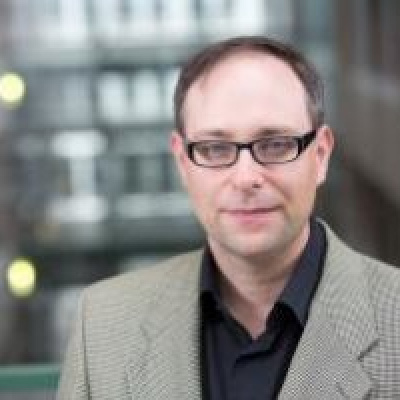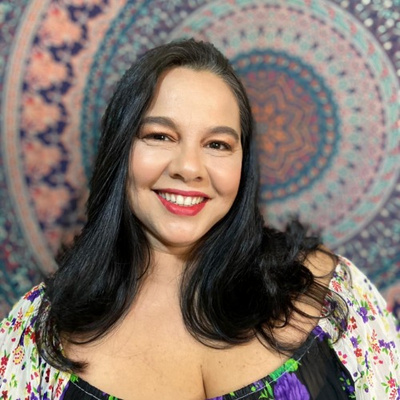A Sequence of Blogs on Expertise and Ethics
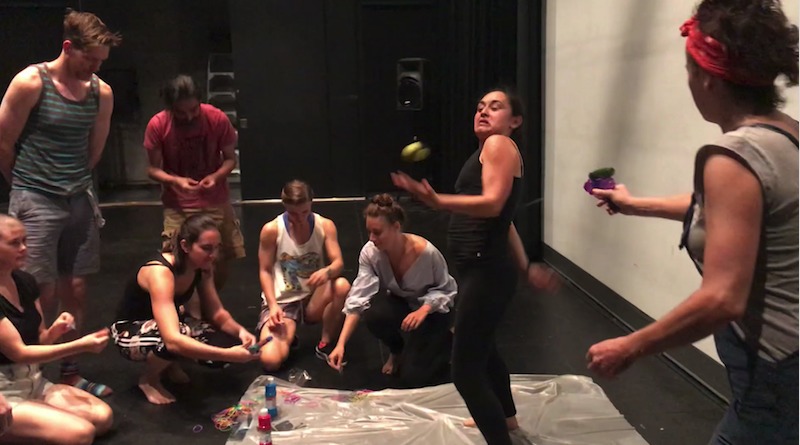
From July 3rd to 13th 2018, over twenty thinker-doers from a dozen countries, all practitioners and scholars of contemporary circus and/or other performing arts, converged onto Montréal during the Montréal Complètement cirque festival to participate in Concordia University’s intensive summer graduate seminar taught by Prof. Louis Patrick Leroux and titled “Experiential learning in Contemporary Circus Practice: Methods in research-creation, action-research and participant observation.” For two weeks, they attended lectures and seminars in the mornings, then in the afternoon, had studio time to work on their presentations or to attend participant-observation sessions as part of a larger research project, and of course, they attended performances in the evening.
In addition to their brief research-creation presentations, the students each produced two to three blogs during this period. We are offering a selection of those blogs. Some are candid, heartfelt, others analytical, some are critical takes, others are musings on students’research. They give a snapshot of what was on people’s minds during the summer intensive.Prof. Leroux and his teaching assistant, Alisan Funk, have also contributed original material to complement the students’ blogs. Check back every Friday until the New Year for an updated article from one of the participants!
From the Workshop to the Question, by Alejandra Jiménez
Since its beginnings, circus has been the place of extravagance, of acrobatics and extreme bodies or bodies pushed to their extreme.
During this summer’s seminar “Research-Creation Methods in Contemporary Circus and Drama,”we took on a great diversity of theories and methods for analysis. We looked especially closely at innovative processes for research-creation. Most of the discussions revolved around experiential learning, embodied knowledge and finding strategies to foster thinking-spaces for students engaged with the creative process.

As an actress, the school experience, the creative and investigative processes in a collectivity and the proper exercise of my profession make it possible for me to get more insights from the reflections on practice and craft foregrounding the corporeal, affective and perceptual (Mc Cormak, 2008). From that perspective our bodies and their abilities, intuitions and emotions are understood as doing-thinking.
As part of the seminar, two workshops were conducted by Sarah Poole and Adrián Martinez (both instructors at ENC). They explored circus as a research method in order to focus on the install, the student’s body in its know-how and to provide a safe space for assuming it one’s body as individual and singular.
Circus and theatre are related and associated with terms such as precision, rigor and routine. They also include the handling of apparatuses and theatre props, which has generated numerous works in relation to dramaturgies, aesthetics, and poetics. The objects come to life; using them provokes their re-signification beyond the condition of accessories and breaks away with the hierarchy present between them and the performers. However, none of these potentialities would be generated without proper training techniques.
Training can be described as the field of exploration, preparation and transformation of the body, voice and as daily actions for the scene. Thus, research through training is, in practice, what Nelson refers to as a dialogue with the situation (2013),as it encourages reflection, autonomy and knowledge incorporation. That knowledge is what allows decision-making in the subsequent creation process, the rehearsal and, finally, the show.
Sarah’s workshop began with questions about the place of origin and the background of each one of the participants. Those questions echoed in my head several days later, because frequent inquiries during the seminar were about skills and abilities. Exploring relaxation, the idle body, falling ,and recovery took me back to my first years in school. For me and for the performers’ bodies, all these themes in common operate in our practices, at least on the body level.
Subsequently, the workshop focused mainly on the use and relationship between objects and their embodiment. Pins, balls, rings and fabrics entered he space in a black rolling box. Two words come to my mind and have since been resonating in my head. Evidently, one of them is circus and the other is background. I imagined immediately that we were going to explore juggling or technical circus elements that were not present in my training and that, in a certain way, would seemingly diminish my performance in the workshop.
How can circus be explored as a method when you don’t share that background? Which specific topics in circus are useful to solve my very first question?
Under these conditions, I observed the other attendees. Many of them, due to their high level and expertise in circus or theatre, assumed a critical stance and had expectations that made me feel insecure about my performance during the workshop. Eugenio Barba (2010) names such uncertainties as dark forces that are installed at the point of origin of the learning in practice. They are the place of convergence between tacit knowledge, exploration, and objectivity.
Sarah’s voice appeared then, building spirals in the body and space. Spirals that she recognized as emerging from her inquiry and quickly she extrapolated to the circus, breaking the linear movements that the techniques of dance had left in her. In this way,these words emerge as a reminder of the possibilities that a body has, even if you do not have experience in circus.

A ball and a piece of fabric became the means that led me to fail, to explore vulnerability and exposure, imbalance and confusion. I was there, with little control over my own movements, a lot of reasoning, and a body creating its own barriers. And Suddenly, my phrase of movement was a complete disaster–which was me making me forget the basic principle—play. It was too much reflection for a two-hour workshop that was turning out to be quite conflicting for me and generating many questions that I can now link. However, what I rescued from it and assumed as a point of reference in the seminar were these two questions:
How can circus be explored as a method when you don’t share that background? Which specific topics in circus are useful to solve my very first question?
At the end of the workshop Sarah proposed a place in the circus that detonated more and more in me: “More curiosity, less ambition.”
And so, let’s go back to training.
Urban space was a field to explore, as well as the performer’s body with her positions capturing and creating new ways of knowledge and experiences for spectators and academia. Today, I am in a dissemination process with the artistic and academic communities in the university where I work. Some undergraduate students are part of a new research-creation group (semillero)on circus that I am organizing. I keep on exploring the new challenges proposed by circus practices in my training and doing-thinking how circus has left a trace in my body.
Alejandra Jiménez Artist, Educator Colombia Alejandra Jiménez is an interdisciplinary artist focused on dynamics and connections between subjectivity and the city, body writing, expanded theatricality, public transport and popular/day-to-day urban performances. She teaches at the Universidad Distrital, Bogotá-Colombia.
It’s Not Because We Can that We Always Should, by Lua Barreto
It was hard for me to write this blog because, then, the only thing I would like to talk about was how amazing this seminar was. However, not everything is la vie en rose, so I have had something burning in my mind since the final artistic presentations. The proposal that was made in the last minute of Alejandra Jiménez[1]’s presentation caused a reaction that surprised me. Perhaps because of the short time left (she had gone over and promised that this would only take one minute), people did not think before acting, but it was still surprising.
After demonstrating her questions regarding research-creation, creating a beautiful image of possibilities and tensions drawn by the acrobatic tissue laid down on the floor, Alejandra told us more or less the following: “Now I’m going to do something that I do not do very well, I’m going to juggle. In the meantime, I’m going to put some things at your disposal (she puts some water jugs and colored paint tubes on the floor). As long as I try to juggle the ball, if I make a mistake, you can use those things to throw at me.” And they did!
Games and art have the power to reveal us, to lead us to unthinking, instinctive acts.
So far, so good. Marina Abramovic already showed, in 1974, what the public is capable of. In her performance Rythm 0, brought to the scene in 1974, she made available to the public 72 items, including scissors, weapons, but also roses and food. For a few hours the artist gave herself to the public, so that they could do with her whatever they wanted. And they did… Human nature itself does not surprise me. What surprised me, in Alejandra’s case, is the fact that there were practically only artists in that audience. What surprises me is that there were people who not only perform artistically (which would be enough to make the situation indigestible), but also articulate artistic concepts, research art, think about art, and, last but not least, teach art! These artists, researchers, and art thinkers didn’t even give the artist time to try. Alejandra exposed herself to the audience while she tried to train a new skill. She invited us to accompany her work in progress, and to judge her performance, if we saw it fit.
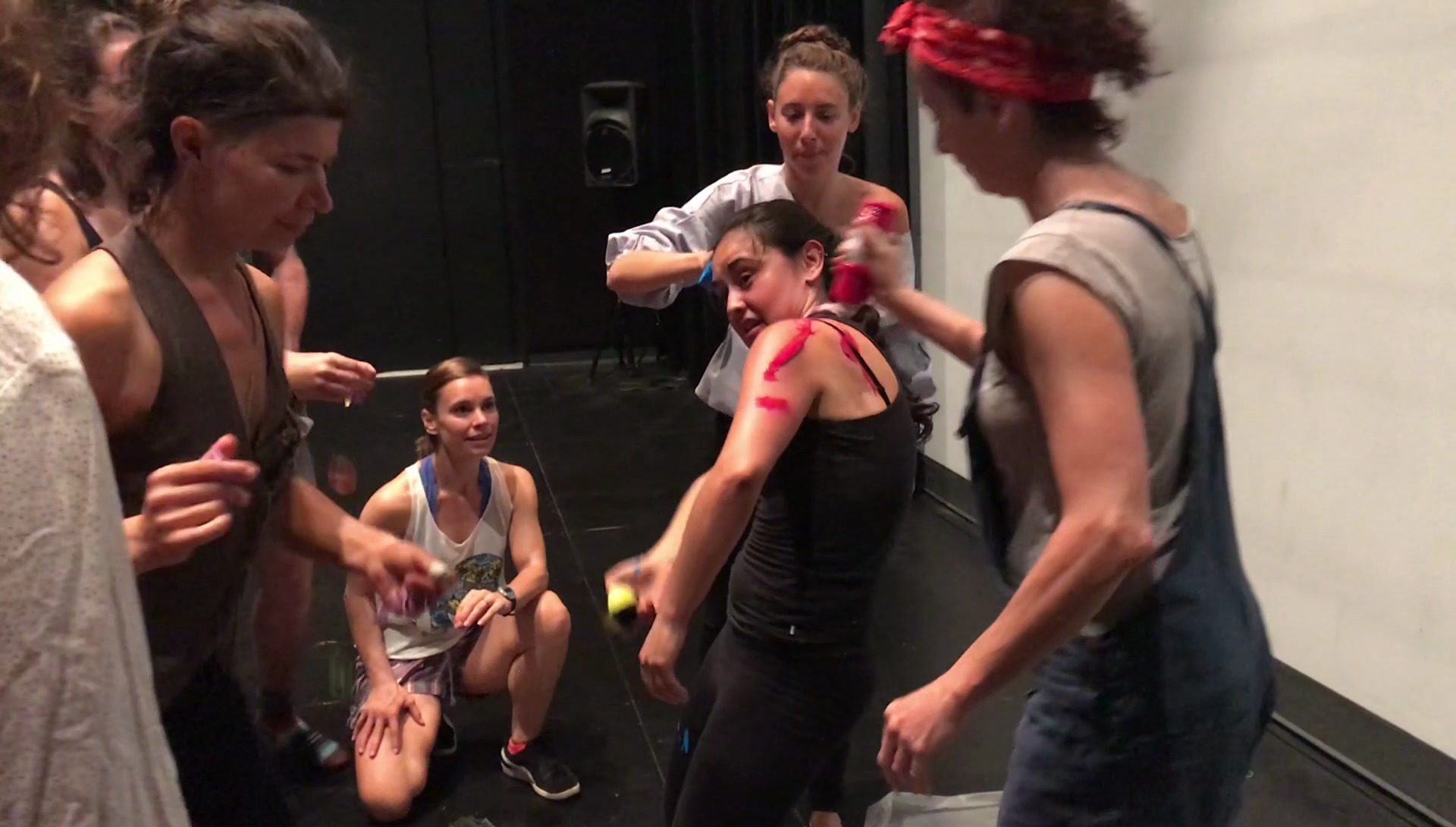
The result was that she could barely catch the balls. People were so eager to throw paint and splash water, that they didn’t even wait for mistakes. Out of about 20 people in the audience, only one extended his hand with the ball (that was Joris) in an attempt to help her practice. The only thing that stopped the rampage was Claudia’s interference, in a protective embrace. Still, people continued to hit the performer with their guns and paint.
What can we conclude from this experience? In 1974 Marina Abramovic concluded that if you leave the public do whatever they want, they can kill you. In fact, a spectator even pointed a gun at her head. Whether he would have shot or not, we do not know, because someone intervened, preventing the action from unfolding. The performer Marina Abramovic set out to test the limits of human behavior. She exposed herself to an unknown audience, completely helpless, to see how far they would go. This was her proposal. However, one thing in Alejandra’s proposal moves us from the place of ‘audience’: what she proposed wasn’t a show or a performance. She said, “I’m going to stay here training and if I make a mistake, you do whatever you think you should do.” What she proposed was a learning process. We were all colleagues, many of whom had just gone through the experience of exposing themselves to this same audience with works in process or unfinished scenes. We had all experienced the insecurity of going public with proposals which we did not know if they were going to work. And we often talked about the fact that the course was a safe space for experimentation. We behaved, we applauded, we supported the work of colleagues, until the moment when weapons were put at our disposal. How quickly we lost our composure and forgot to support the errors of our neighbor when we had the power to judge… I wondered if those water pistols had been delivered to us at the beginning of everyone’s presentation, if Alejandra’s entreaty to “correct” inability would have stopped us all from finishing our own presentation.
It is hard to believe that a group of artists, of people who research and critique art, did not think about the meaning of that act, or that we would hear the justifications we usually hear in these cases: it was just a scene, we were just playing, or we were playing a role. Games and art have the power to reveal us, to lead us to unthinking, instinctive acts. So, what is our attitude towards someone who is learning? What role do we individually play? Is the role of those who humiliate the apprentices to mock them? Is it to punish mistakes? Is the role of someone who disturbs learning for the fun of painting on a colleague? Of someone who protects, even if this prevents learning? Or of the one who reaches out with the ball in an attempt to encourage the apprentice?
This study was financed in part by the Coordenação de Aperfeiçoamento de Pessoal de Nível Superior - Brasil (CAPES) - Finance Code 001 CircusTalk is publishing this study as a courtesy and was not involved in the research project or funding of this project.
Lua Barreto Researcher, Educator BRAZIL Lua Barreto is a PhD candidate in Physical Education at Universidade de Campinas. She holds a Master’s in Cultural Performances from UniversidadeFederal de Goiás (2017) and previously studied acting at Universidade do Rio de Janeiro and Estácio (2005). She also has a graduate degree in University Teaching from Pontífice Universidade Católica (2006).
Feeling at home, by Claudia Funchal
When we were waiting for one of the workshops to begin, I told Camila, a young professor from Uruguay: “You know, I feel at home in this place.” I did not mean the building itself, but the opportunity of creating through movements. I love to see how much we can learn by trying out new paths, by letting our bodies surprise us. Moving in a way I have never moved before means first and above all that I will have to face my fears and limitations.
I am a clown. This tacit place of fear and vulnerability is priceless. It creates a gap that is not supposed to be filled alone: an empty space where a connection with the audience is possible. I am an actress and a clown. My skills are not predominantly from circus. I do not have a background experience with a circus troupe, so I do not have circus skills like juggling, walking on tightrope nor any other similar ability.
Although I am not sure about my place in any kind of circus or circus research group, it is where I feel at home.
I am a very nomadic person. When I was a child my family was a very nomadic family, as an adult my own family is very nomadic, thus far I have lived in more than a dozen different houses, in ten different cities in Brazil and in Canada.
When I say “home” I do not mean a particular, concrete image of it as a specific place, but instead, my “feeling at home” is a set of tacit and kinesthetic memories.
I do not have detailed recollectionsof all those rooms I used to call my bedroom. I do remember, though, running to the school before dawn for my physical education classes in Campo Grande, fighting the waves in Copacabana Beach to get out of the ocean, just to go back in again, or even playing dodgeball until after dusk in Brasilia, then hiking somewhere else, ballets classes I do not know where, and some other beach, and then some falling snow flakes melting on my hands in Québec.
On the other hand, all these moves and movements have been building my identity, some peculiar way of physical and verbal expression, some nonstandard accent that brings pointed fingers on me, some way of moving that brings the gaze of the crowd all over my body.
I was 18 years old, when I first stepped into the old loft theatre of the Department of Theatre of the University of Campinas, Brazil. I felt at home, I fell in love with Juliet and the angel-like cupid gazing at me. That place came to be my home through the years in which I was completing my theatre major. In those four years,my former and insipient notions on the relationship between audience and performers were put down.
During the 2018 summer seminar at Concordia, that 24-years old feeling was renewed, I felt at home in a place in whichI had never been before. Maybe it was my intuition unveiling something incipient yet again.
We were 22 artists from 12 different countries, studying research-creation methods in contemporary circus and drama. Talented people from different backgrounds were creating, thinking and doing-knowing(Nelson 40) together. At this point ,it is pleonastic to state that I am familiar with diversity, that diversity is home for me. Circus culture is built from diversity – diverse skills, diverse bodies, diverse nationalities, diverse learning processes. That group was as artistically and academically diverse as a group of 22 people can be.
The delicacy of such manifold raised the curtains on my fears. My theoretical background comes from theatre; my body knows the clown and its vulnerability, throughout all these years of theatre formation, I have been experiencing many techniques, without any specialization though. The only thing I have been juggling with is the vulnerability, playfulness, and connection triangle. How successful in such performancecan be the clown I have been playing?
Without playfulness, connection cannot be launched.
In the last day of the seminar, Alejandra proposed a performance in which audience was invited to act. She would try to do something she did not master: to juggle with balls. She laid some objects in front of the scene and told audience that they could throw any of those objects at her every time she made a mistake.
Images from Marina Abramovic’s performance Rhythm 0 came to my mind.
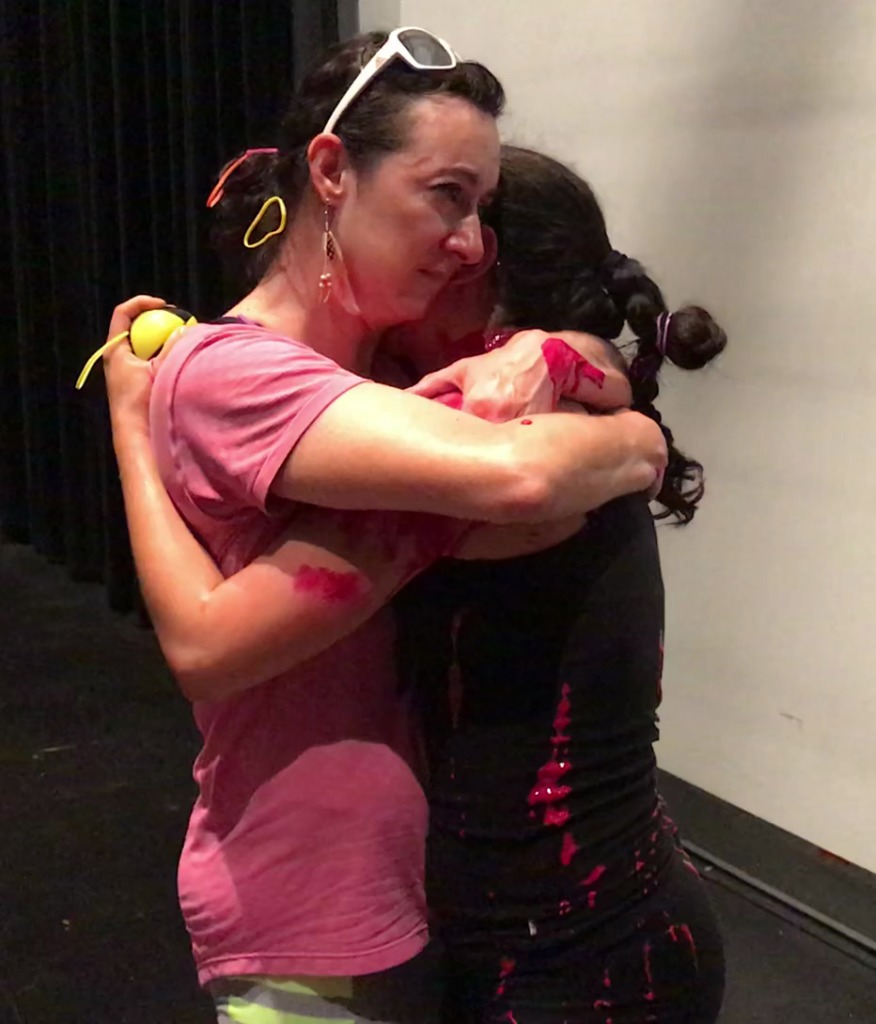
I did not want to play. My first reaction after hearing the proposition of Alejandra was not to play at all. I was so familiar with this proposition thatI could not be at ease. I knew the outcome of it. I knew people would follow the “instructions” and throw things at the performer. I had just presented an exercise of clown duo, and I was feeling more sensitive than usual. Then, after a few minutes of watching people throwing things at her, I ran to Alejandra and embraced her. By protecting her, I stopped the performance. My act raised many questions, let’s explore some of them.
For starting, why did I suppose that people would, indeed, use those objects? As Lua noted, we were not some lay audience, we were a closed group of artists and teachers in a research context. However, many of us felt compelled to act according to Alejandra’s suggestion. We were given permission to do so, though we were free not to. It felt like not using our freedom completely.
And then, what about our practice as research? When comparing the structure of the performance to the structure of a technique, how do we stablish roles beyond the roles we know are possible? How do we decide to put aside roles we are used to play? Do we explore entirely our freedom? How is failure in a practice as research room different from failure on stage?
Somehow, I am more interested in the learning process than in the performance itself. I love to see how space and relations can be transformed through the creative process, in a moment where vulnerability, failure, playfulness,and connection dance together. That is why I love performances where the audience can participate actively. When the public is invited to participate, the creative process never ends and the possibilities remain always open.
Afterwards, I came to realize that in the performance of Alejandra, we (the research group as whole) threw just the first ball: vulnerability. We were too serious following the rules, we forgot to throw the second one: playfulness. Without playfulness, connection cannot be launched. Connection grows in this empty space between the rules, gaps that are not supposed to be filled, especially with any other rule, where we can throw ourselves and feel at home.
In some respects, as researchers, we have more freedom to fail. But this freedom cannot be fully appreciated if we are not open to perceive the hidden paths that run along the edge of intuition. We can break the rules, we can follow the rules, but we must also find the places where rules are not supposed to be.
I embraced Alejandra because I was afraid. I was held back by my lack of understanding of the situation, my limitation as a human being. I failed to perceive that, despite our fears, we must leave the cozy riverboat sailing and wade towards the jungle that grows on the banks of the river. We must not forget: places we have never been before can surprisingly feel like home.
Claudia Funchal Researcher, actress, clown BRAZIL Claudia is a theatre researcher, actress and clown, currently studying for a PhD at Université Laval, Québec. She holds a Master’s degree in theatre from University of São Paulo State (UNESP), Brazil. To contact Claudia, please send an e-mail to [email protected].
Technical Skill as Exclusion?, by Louis Patrick Leroux
What is our responsibility in the face of intellectual and aesthetic provocation? Do we leap up and react (as is expected of us?), do we take full measure of what is being put forth, do we intervene to keep people from intervening when the exact purpose of the provocation—artistic or otherwise—is to make us go through with gestures we’ll invariably regret?
Alejandra’s performance tested these moral and artistic limits as well as pedagogical ones. In the context of a seminar on the experiential that was populated with thinker-doers generally impatient to do, to get involved, it set up a particular conundrum. After showing us extremely high competency in her artistic mediums (acting, physical theatre), she spectacularized her sense of inadequacy and reflected it back onto us.

A highly trained physical actress, reminded by circus practitioners that their technical abilities are beyond her reach, in the end, asks them to pelt her with paint with each failed attempt at juggling. Students were willing as they were requested to participate and wanted to show support. Because of this, it was a heart-wrenching performance bringing us to reflect upon “expertise,” our own and other’s. It was a performance as pedagogy—a reminder by our Colombian student to keep in check our cocky North American appreciation for high technicity and the “wow” factor. This artist could—and did—wow us with her own skills. Only during the concluding moment (the chute as the French like to call it: both “fall” and “final punch”), as she stood there, her body the canvas of action painting by her peers—the “action” being joyful reprimand—did everyone take full measure of what they had done, as Alejandra stood there, Claudia wrapping her arms around her—pure empathy—and others stumbling away, realizing the depth of the experience.
This was one of many moments where the meeting of so many worlds, artistic sensibilities and worldviews was most poignant. There were many others. There were 21 performances, each of them strong and fascinating. We wept as Ülfet had us participate in her exploration of the disappeared women in Syria; jumped from “continent” to continent of as yet-to-be-recycled refuse from Simone’s trip as she challenged us with political burlesque; Andrée-Anne Giguère and Claudia Funchal’s performance installation, a meta-piece on research-creation methodology gave us a glimpse of what could become a very effective classroom methodology, and so one and so forth! I would have loved to present them all, but Alejandra’s piece prompted a series of blog responses in the seminar that I feel captured much of the essence of the discussions and embodied practice. We gave ourselves space to think, to exchange, to work physically, to engage, to watch others work and to discuss not only shows but also what mattered most to us.
Related content:The Body in Waiting, Circus Summer Seminar in Montreal, Meanwhile, Backstage…, What It Means When Circus Artists Take Part in Graduate Research Courses, The More We Learn the Less I Know, Simple Thoughts , Coffee talk with Maddy and Stacey–Finding the Intersection Between Circus & Dance,and The Male Duo in Circus, Un Poyo Rojo & Chute! All Experiential Learning in Contemporary Circus Practice Seminar articles provided were edited with the help of Caroline Fournier-Roy, M.A. student of English Literature at Concordia. All photos are screenshots of the video taken by Andrèe-Anne Giguère. Presentation of Burning the house by Alejandra Jiménez. Concordia University. Black Box. July 2018
Editor's Note: At StageLync, an international platform for the performing arts, we celebrate the diversity of our writers' backgrounds. We recognize and support their choice to use either American or British English in their articles, respecting their individual preferences and origins. This policy allows us to embrace a wide range of linguistic expressions, enriching our content and reflecting the global nature of our community.
🎧 Join us on the StageLync Podcast for inspiring stories from the world of performing arts! Tune in to hear from the creative minds who bring magic to life, both onstage and behind the scenes. 🎙️ 👉 Listen now!
